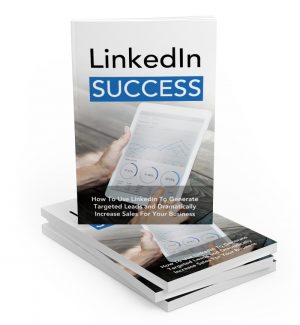 License Type: Master Resell Rights
License Type: Master Resell Rights  File Type: ZIP
File Type: ZIP
 SKU: 62442
SKU: 62442  Shipping: Online Download
Shipping: Online Download
Sample Content Preview
Introduction
The Internet’s impact on business over the years has been, and continues to be, profound and ubiquitous. It has enabled what were once, local and small industries and businesses owners to reach people around the world. Businesses can no longer define their competition by geographical boundaries or a level playing field where all players are bound by the same rules.
Major market disrupters like Airbnb, Uber, Netflix, and Alibaba are turning what were at a time considered A-grade business models into relics of the past. The impact is set to continue, even more rapidly, over the next several years. For many companies, it will mean an even tougher business environment. There will continue to be more disrupters emerging, which will become agile and nimble businesses that will dominate the markets. There will be more start-ups with savvy entrepreneurial backing that will become overnight successes.
LinkedIn has emerged as one of the main powerhouses on the Internet for business leads and sales and now has more than 500 million users around the world. The business networking platform was started in 2002, by the founder of PayPal, Reid Hoffman. The company has seen steady growth since its official launch in 2003. LinkedIn has earned a reputation as the social media platform that entrepreneurs can use to find the right buyers and quality leads online.
LinkedIn stands out from the other social media platforms, because the majority of LinkedIn members log into LinkedIn with the intention of networking with other like-minded individuals. One of LinkedIn’s greatest benefits is its ability to enable entrepreneurs to connect with small business owners, CEOs, VPs, key decision makers, other entrepreneurs, and potential customers. The professional networking platform gives entrepreneurs an effective digital platform for finding and engaging with their ideal customers and to build a sustainable business relationship with them.
Unlike decades past, LinkedIn allows you to research companies and locate the decision makers without having to resort to spending your days cold calling. LinkedIn allows you to engage with your ideal prospect through groups and recommendations from your first-degree contacts. This new strategy, also known as social selling, hasn’t been fully embraced by the business world yet. However, those businesses that have embraced social selling and integrated those strategies into their sales process have yielded greater benefits.
Understanding how to utilize LinkedIn as a business can create a substantial difference in the number of highly targeted leads that you can generate. If you aren’t already using LinkedIn marketing in your online marketing strategy, the following chapters will show you how you can optimize your LinkedIn profile and use its unique features to generate more targeted leads and dramatically increase sales for your business. The networking opportunities afforded by being a member of LinkedIn are invaluable, and the marketing opportunities are vast.
Chapter 1 – The Current State of LinkedIn
As previously stated, LinkedIn has a network of over 500 million members, of which, 46 million of those users are students that are looking to get a jumpstart on their career search or are recent graduates. This is a huge audience for your business to market to. However, there are many features available to business marketers that narrow down the target audience, even as the network continues to grow.
With that many members, it’s hard to imagine not using LinkedIn in your business marketing strategy. When Microsoft acquired the platform in 2016, it enabled the company to look further into what LinkedIn can do for all of its members. In October of 2018, LinkedIn partnered with Oracle, a software company that specializes in databases, to announce that it has several new integrations working the two businesses together. The most prominent of the integrations is the overhaul of the recruitment tools, which makes maneuvering back and forth between screens easier for recruiter and finding talent easier and more streamlined, among other things.
Recruiter can now use the LinkedIn sourcing with Oracle Recruiting to find more candidates recommended by the “Recommended Matches,” who show candidates based on position fitness. This has allowed Administrators and Recruiters the ability to see the skills of their current employees, any gaps that they might have, and it enables them to compare their workforce with their competitor’s workforce.
Oracle customers also gained access to the LinkedIn Learning feature, which means they can now use the learning catalog offered by LinkedIn, and a centralized location for administrators to view which of their employees have accessed and completed courses. Administrators can also view reports on engagement with the course. Currently there are 30 to 50 new courses offered every month, including courses on how to make work environments more inclusive. Some of the other new features on LinkedIn Learning include the following.
• Insights and recommendations for making the learning more relevant. • Allowing administrators to add their own content, or use third-party created videos. • Upload, manage, and track videos. • Reports showing the progress of learners and the completion of videos. • Tag videos to make searching videos for content based on purpose easier.
Microsoft products are also seeing updates. In Microsoft’s email software, users can now see the profile information on the people in their contacts and in 2019 will add insights into the people you meet with to further personalize interactions. Collaborating with members on LinkedIn will be easier as well since you will now be able to create content in Microsoft Word, Excel, or PowerPoint with your connections even if you don’t have their email address. The “Groups” feature in LinkedIn has also undergone improvements. It is available now in the app, with the ability to manage, post, and edit content as well as accept join requires and all other moderator functions and receive notifications of activity.
Searching for jobs will also be easier. When searching for jobs and entering criteria, the option for “remote jobs” is in the “location” checkbox, and jobs offering telecommuting or working from home will be the posted results. Company information on the right side of the screen now shows quick context for each posted job so users don’t have to leave the search results page. The option for notifications when certain companies and positions open up is also a newly available feature in LinkedIn.
LinkedIn has many new integrations and feature updates planned for the future. It will be more dependent on Artificial Intelligence (AI) to get to know a member’s clients and make minor decisions, including scheduling, accepting or denying connection requests, and facilitating meeting mutually beneficial people. Virtual meetings will allow face to face contact without having to leave the office. Video profiles will replace regular resumes and give opportunities to add personality to your self-promotion.
LinkedIn will start allowing Learning Lounges to be set up as virtual training centers, and will offer resources to current employees and potential candidates to help them improve their current skills or learn new ones. This will be helpful for both recruiters and candidates because it will show a candidate’s willingness to learn new skills as well as their adaptability to changes that may be required in their position.
LinkedIn for Business
Another new feature that businesses should take advantage of is the Campaign Manager feature. This new feature will automatically adjust bids on sponsored content through the automated bidding feature so businesses can gain the optimal outcomes for their advertising budgets. The Campaign Manager feature, allows marketers to put in an objective and the automatic bidding feature will find the best members to fulfill the objective. Advertising will now be allowed on personal pages as well to support the branding of products for smaller businesses.
Customer-centric marketing will start to become more prominent when the AI elements begin to change how we use digital products and how we communicate online.
These days, the business to customer buying cycle is getting much shorter because of recommendations from artificial intelligence compiled data. Customers are starting to rely more on the data compiled by the artificial intelligence. This allows them to make minor purchases on behalf of them, which becomes more passes in their buying cycle. However, the opposite is true of business to business buying cycle. That cycle is getting longer due to more consideration of and deeper examination proffered of the proffered content.








